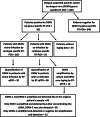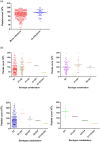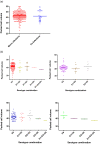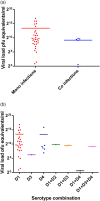Dengue virus co-infections with multiple serotypes do not result in a different clinical outcome compared to mono-infections
- PMID: 32594967
- PMCID: PMC7325333
- DOI: 10.1017/S0950268820000229
Dengue virus co-infections with multiple serotypes do not result in a different clinical outcome compared to mono-infections
Abstract
Circulation of multiple dengue virus (DENV) serotypes in a locale has resulted in individuals becoming infected with mixed serotypes. This research was undertaken to study the clinical presentation, presence of DENV serotypes and serological characteristics of DENV infected patients with co-infections from three Provinces of Sri Lanka where DENV-1 and -2 predominated during the study. A reverse transcription polymerase chain reaction was performed on 1249 patient samples and 301 were positive for DENV (24.1%). DENV-1 was the predominant serotype detected in 137 (45.51%) followed by DENV-2 in 65 (21.59%), DENV-3 in 59 (19.6%) and DENV-4 in 4 (1.32%) patients with mono-infections. Thirty-three patients (10.96%) had DENV co-infections with two or more serotypes. The highest number of co-infections was noted between DENV-1 and DENV-2 (57.57%) suggesting co-infection is driven by the frequency of the circulating serotypes. Platelet counts were significantly higher in DENV co-infected patients although clinical disease severity or white blood cell count, packed cell volume or viraemia were not significantly different in the co-infected compared to the mono-infected patients. Thus co-infection with multiple DENV serotypes does occur but with the exception of improved platelet counts in co-infected patients, there is no evidence that clinical or laboratory measures of disease are altered.
Keywords: DENV co-infections; Dengue; RT-PCR; Sri Lanka.
Conflict of interest statement
‘None.’
Figures





Similar articles
-
Impact of dengue virus (DENV) co-infection on clinical manifestations, disease severity and laboratory parameters.BMC Infect Dis. 2016 Aug 11;16(1):406. doi: 10.1186/s12879-016-1731-8. BMC Infect Dis. 2016. PMID: 27514512 Free PMC article.
-
Circulating dengue virus serotypes and vertical transmission in Aedes larvae during outbreak and inter-outbreak seasons in a high dengue risk area of Sri Lanka.Parasit Vectors. 2021 Dec 23;14(1):614. doi: 10.1186/s13071-021-05114-5. Parasit Vectors. 2021. PMID: 34949219 Free PMC article.
-
Analysis of Dengue Serotype 4 in Sri Lanka during the 2012-2013 Dengue Epidemic.Am J Trop Med Hyg. 2017 Jul;97(1):130-136. doi: 10.4269/ajtmh.16-0540. Am J Trop Med Hyg. 2017. PMID: 28719296 Free PMC article.
-
Evolution of dengue in Sri Lanka-changes in the virus, vector, and climate.Int J Infect Dis. 2014 Feb;19:6-12. doi: 10.1016/j.ijid.2013.10.012. Epub 2013 Dec 11. Int J Infect Dis. 2014. PMID: 24334026 Review.
-
Concurrent dengue infections: Epidemiology & clinical implications.Indian J Med Res. 2021 May;154(5):669-679. doi: 10.4103/ijmr.IJMR_1219_18. Indian J Med Res. 2021. PMID: 35532585 Free PMC article. Review.
Cited by
-
Single B cell transcriptomics identifies multiple isotypes of broadly neutralizing antibodies against flaviviruses.PLoS Pathog. 2023 Oct 9;19(10):e1011722. doi: 10.1371/journal.ppat.1011722. eCollection 2023 Oct. PLoS Pathog. 2023. PMID: 37812640 Free PMC article.
-
Concurrent circulation of dengue serotype 1, 2 and 3 among acute febrile patients in Cameroon.PLoS Negl Trop Dis. 2021 Oct 25;15(10):e0009860. doi: 10.1371/journal.pntd.0009860. eCollection 2021 Oct. PLoS Negl Trop Dis. 2021. PMID: 34695135 Free PMC article.
-
Relationship between clinical and laboratory features with infecting dengue virus serotypes in a sample of dengue suspected adult patients from 2015-2017 in Sri Lanka.J Clin Virol Plus. 2022 Nov;2(4):None. doi: 10.1016/j.jcvp.2022.100112. J Clin Virol Plus. 2022. PMID: 36518528 Free PMC article.
-
Epidemiological burden of dengue in Sri Lanka: A systematic review of literature from 2000-2020.IJID Reg. 2024 Aug 24;13:100436. doi: 10.1016/j.ijregi.2024.100436. eCollection 2024 Dec. IJID Reg. 2024. PMID: 39386112 Free PMC article. Review.
-
COVID-19 prevention measures reduce dengue spread in Yunnan Province, China, but do not reduce established outbreak.Emerg Microbes Infect. 2022 Dec;11(1):240-249. doi: 10.1080/22221751.2021.2022438. Emerg Microbes Infect. 2022. PMID: 34935597 Free PMC article.
References
-
- Senaratne TN and Noordeen F (2014) Diagnosis of dengue in Sri Lanka: improvements to the existing state of the art in the island. Transactions of the Royal Society of Tropical Medicine and Hygiene 108, 685–691. - PubMed
-
- Sirisena PD and Noordeen F (2014) Evolution of dengue in Sri Lanka-changes in the virus, vector, and climate. Internatioal Journal of Infectious Diseases 19, 6–12. - PubMed
-
- Senaratne T et al. (2016) Characterization of dengue virus infections in a sample of patients suggests unique clinical, immunological, and virological profiles that impact on the diagnosis of dengue and dengue hemorrhagic fever. Journal of Medical Virology 88, 1703–1710. - PubMed
Publication types
MeSH terms
LinkOut - more resources
Full Text Sources
Medical

